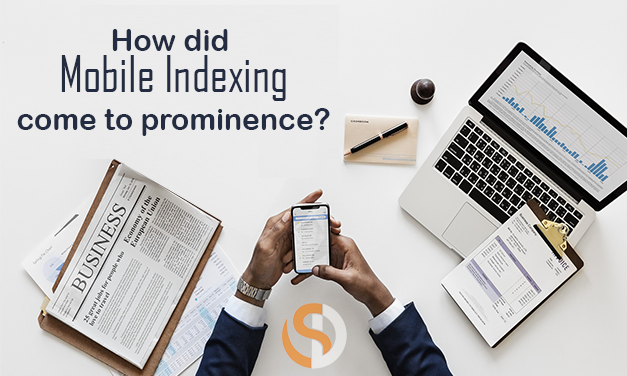There is a proverb – Change is permanent. The statement may be simple, but it sums up the very aspect of human existence. In 1980, the talk was about computers. While the 1990s, it was the internet. In 2000, it was the mobiles, and in the middle of 2016, it was the apps. Similar is the case with websites. First, it was left only to the mighty to have an online presence, but of late, every individual (who wants to create an identity or make easy money) has a website. The pattern in websites also changed. In the initial stages, there was only content. Then SEO arrived, and then digital marketing. And the most important of all was the Google Indexing. In recent times, it is the mobile-first indexing, that has gained attention. Every company, worth its value on the internet is pretty confused about the advancements leading to mobile indexing. So, in this article, we will see how mobile indexing came into prominence.
Table of Contents
Why is Mobile Indexing Important?
As per industry experts, the indexing part is large because of Google’s efforts to convert the web into a mobile-friendly place. The indexing is mainly based on user behaviour trends. But yes, a new update comes and unless there is a proper explanation, rumours tend to fly high. For the average e-commerce business owner, it is like sitting on the fence. Does he/she have to change everything? Is it okay, if your website is only the mobile friendly?

Before venturing into the very depths of indexing and every information, let us break the huge amount of doubts step-by-step. Let us first look into mobile indexing and then we can go towards the higher points.
Mobile Indexing. The title clarifies the meaning. In short, the mobile version of the website is considered the starting point of the index of Google. In fact, even the rankings can change. Usually, instead of mobile indexing, it is called the mobile-first index. In case your business does not have a mobile responsive website, then you can still include the website in the index. But note, the lack of a mobile responsive website can play havoc on your rankings. A site with the best mobile responsive nature can receive a boost in the rankings even for desktop users.
Let us imagine, you are a smart guy. Having received intimation that the mobile indexing will be an integral part of the future, you invested some money in the website and converted it as per the norms. In such cases, do you have to do anything? A big NO. The change will not hamper nor bring about any changes in your website rankings.
But, the rules have been made. No escapes. So Google is set upon prioritizing crawling and indexation even to mobile responsive themes. Till recently, it was only the desktop version that was considered primary. The mobile version – secondary. There were many who took advantage of this change of google. The desktop version used to be complete – SEO, images, digital marketing strategies, and a complete set of features. But when it comes to the online version, it was the opposite.
So, if your website is not responsive to mobile indexing, what should you do?
Do you need to feel tensed? Never. Because Google is only in the initial stages of testing. Google has selected the websites who can move over from the previous to the present format. If your website looks similar in both the desktop and mobile versions, then there is no need for the upgrade. But yes, are you happy with the present day rankings of your website?
The recent times is the era of millennials. They are more interested in their mobiles than on the world. They search for information only in their mobiles. So, there is no harm in Google thinking of them to have the best experience. But what are the criteria for a mobile responsive site? The page speed of the website and loading time stands as the crucial factor. Others are the optimization of images and the category tabs optimized properly for the visitor experience. Instead of beating around the bush, shall we look into detail?
Content
Whether a business guy or a passionate owner of your website, you have to ensure the mobile version has all the best content existing on the desktop site. And that includes every aspect such as the images, videos and text. Double check to ensure the formats used in mobile versions are indexable and easily crawlable (remember the alt-attributes for images or SEO ready images).
Structured Data
The structure of the data markup on both mobiles and desktop versions should be similar. You should refrain from adding the unnecessary structured data if the words are not relevant to the content of the page.
Metadata
Also, cross-check the meta description and title stand equivalent on both versions. They should be the same for all ages.
Social Media Links
 The twitter cards and other popular social media tabs should have proper exposure even in the mobile version.
The twitter cards and other popular social media tabs should have proper exposure even in the mobile version.
Media Sitemaps and XML
Have you given a link to a sitemap in the desktop version? Ensure that it is also seen clearly in the mobile version.
Search Console Verification
In case you have verified only the desktop version, do not forget to verify the other version.
Apps
If you have an app, get it indexed for both the versions. And for the mobile version, check if you have verified in accordance with the app association files.
Navigation
In both the versions, the navigation tab assumes prime significance.
In few years, Google will bring an index, where mobile versions assume prime significance.
Read Also: On-Page SEO hacks that improve your Website Ranking
If you do not have the mobile indexing version of your website
No problem. Your website gets to the indexing point. But there will be the change in rankings. Google will summarize as the website on the mobile gives the visitors a bad user experience.
Conclusion
So, there ends the article on how did mobile indexing come to prominence? To summarize, it will be just one point. Google wants the indexing and results to be based on many user’s experiences. However, it may be months away before the final fall out. The test is still in the pipeline. If they get a favourable response, they will proceed. Or else, they will retake the older version of giving prominence only to desktop versions. Let us imagine, you have started an online company specializing in washing machine service in Pune. You have a desktop website and an office number. A customer can call and place a request for the repair or maintenance to be done as per his/her convenience. Your trusted team of verified professionals, will go to the home and provide doorstep repair services. Now, you are caught in a fix. Your desktop version is excellent, and you get at least 50 orders per day. But you have not done the mobile version. After receiving the update, you updated the version for your mobile and made it mobile responsive. Now, you are getting more orders, in the range of 55 to 60 per day.








2 Comments
aditya
September 30, 2018 at 1:06 pmDoes AMP play an important role for any website? Since my website is mobile friendly, but I do use amp support, so using it will be beneficial or not?? I too see drop in my ranking, so it is mobile indexing penalty or any other algorithmic penalty
Darshan Saroya
September 30, 2018 at 1:30 pmNo need to use AMP. AMP play an important role for news sites. But your site loading must be less. Loading time metters.